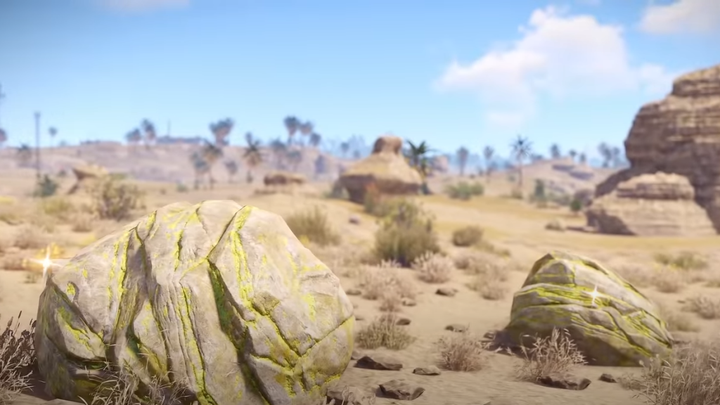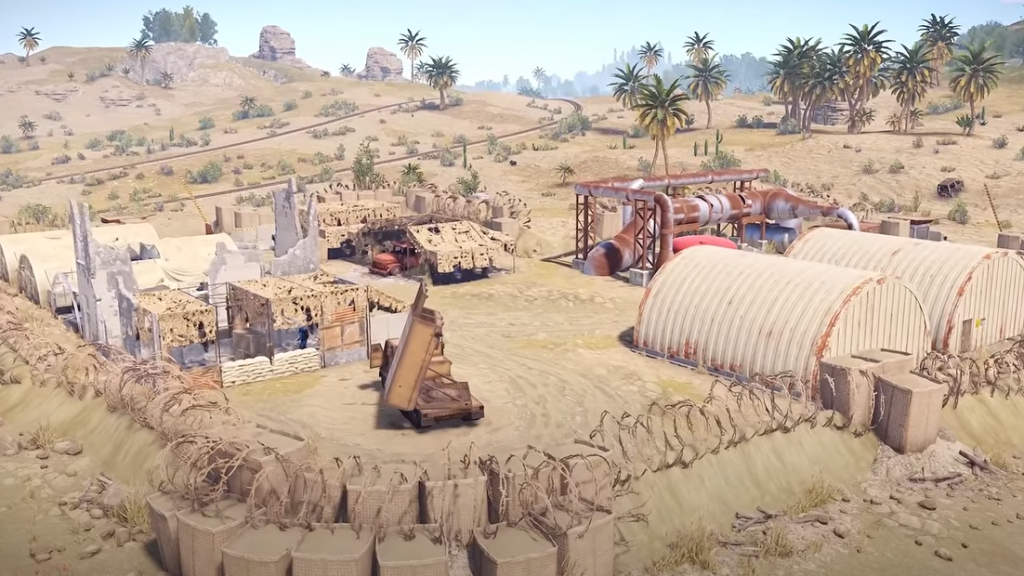Are you looking for the best way to endure the Desert Biome in Rust? Then, stop what you're doing -- we've got you covered. This guide will take you through everything you need to know to survive and thrive in this harsh and unforgiving environment, from how to survive the Desert Biome's extreme temperatures to farming and animals.
We'll also go over all the monuments and some of the best Desert Biome base locations in Rust. With many resources, diverse terrains, and unique challenges awaiting Rust players, the Desert Biome is an exhilarating setting for exploration and settlement. So equip yourself with your finest Mad Max attire as we explain how to survive the Desert Biome in Rust.
Table of Contents
Rust Desert Biome: Best Clothing To Survive
The temperature in the Desert Biome can vary greatly, depending on the time of day, clothing equipped, and your character's level of wetness. For example, if you are naked, the temperature can range from 34.5 degrees during the day to -7 degrees at night. In contrast, the hottest temperature you can experience is 58 degrees, which only causes you to lose water faster. In this case, you'll want to ensure you have campfires ready and stay dry where possible.
To maintain your body temperature, it's important to wear appropriate clothing. The minimum amount of cold protection you need is 17 to avoid taking damage during cold desert nights, and the maximum is 13 to prevent overheating during the day. It's also worth noting that heaters can cool you down, which can be useful if you want to stay at a constant temperature in your house.
We suggest equipping the PVP kit or hazmat attire for daytime PvP encounters. However, switching to warmer clothing during the night is essential to mitigate the dropping temperatures. Additionally, the Desert Biome is relatively less severe than the Arctic Biome, allowing for a greater emphasis on projectile protection. Therefore, donning a complete set of metal armor during the day is not as detrimental as in the snow biome.
Rust Desert Biome: Resources & Animals
The Desert Biome in Rust contains plenty of metal, sulfur, and stone nodes, making it a great place for mining. Cacti can be found all over the landscape and yield food and cloth. Beyond this, some rivers provide a wealth of pumpkin and corn plants. The seeds for crops remain at 100% temperature conditions both day and night, making it an excellent biome for farming.
In addition, you can see many pigs and wolves roaming the desert land, providing you with a source of meat and animal fat. If you encounter them, bring a building plan and some wood to build a foundation to fight better and escape the animals if needed. Then, use the high ground to farm them with a spear for quick and easy resources.
Rust Desert Biome: Best Base Locations & Monuments
Monuments
Monuments within the Desert Biome of Rust feature many resources, making them a hotspot for player activity. There's also a diverse array of randomly spawning monuments. The Large Excavator stands out as the most resource-rich monument. At the same time, the Abandoned Military Base offers the coveted MLRS, enabling players to launch rockets at any base within the server.
These monuments often become hotly contested, necessitating the presence of formidable weapons, sturdy armor, and possibly a group of allies to control and utilize their offerings effectively. However, exercise caution when using the MLRS, as its deployment can swiftly give rise to chaos and ensuing conflict.
Base Locations
When selecting the best location to establish your base within the Desert Biome, several key options present themselves. The expansive desert plains provide ample open space for constructing a compound or village, while rock formations offer the advantage of natural concealment, with rocks serving as free walls. Caves offer heightened stealth and safety but remain highly coveted by other players, requiring preparedness for potential conflicts over coveted locations.
Shallow lakes provide both ample space and an auditory advantage, as the sound of approaching players traversing water becomes easily discernible. The Large Excavator monument proves a popular base location, affording the ability to effectively counter attacks or utilize its resources to one's advantage. Lastly, building on or near rivers grants access to a fresh food and water source, ideal for those planning to cultivate crops.
The desert biome is a great choice if you want a change from the Forest Biome and a more convenient experience than the snow. However, it has many larger and scarier clan bases due to its excellent farming conditions, abundant sulfur spawns, and flat terrain. And that concludes our guide on how to survive the Desert Biome Guide in Rust. While you're here, why not continue by reading our best base defense guide.
All images featured in this guide are courtesy of YouTube/ Jfarr.
For more Rust news, be sure to check out our dedicated section or take a look at some of our Guides & Tutorials just below:
- Beginner’s Guide & Tips to Get Started |
- Where to Find Keycards in Rust |
- How to Fly Minicopter and Best Training Server |
- How to Use Rf to Detonate C4 |
- How to Use the Crafter & Splitter |
- How to Get & Use Conveyor |
- How to Craft & Use Electric Furnace |
- How to Get Gunpowder |
- How to Get Ptz CCTV |
- How to Craft Drones |
- How to Craft Sleeping Bag |
- How to Get Cloth |
- How to Setup Traps & Turrets |
- Vending Machines Guide: How to Build, Defend & Placement Locations

 No ads, our video library,
No ads, our video library,



